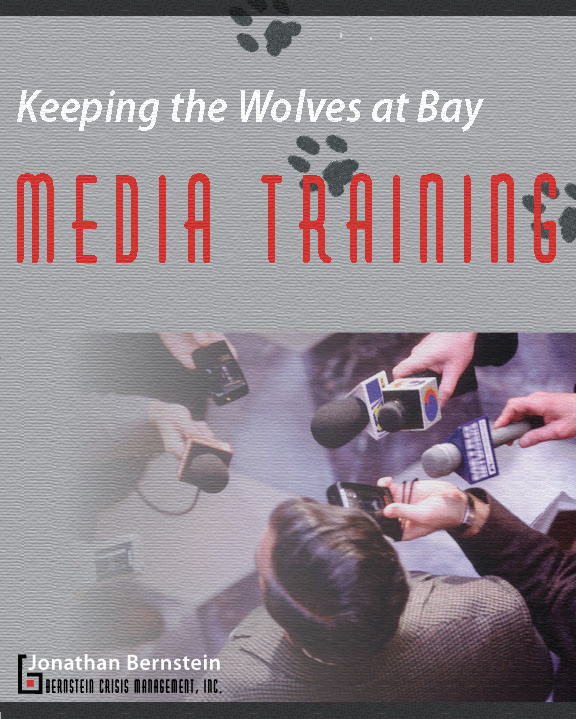|
JUST A THOUGHT
| |
Media relations isn't about being friends with the media. It's about making a connection with them so you can both get what you need.
Bruce Bonafede
Bonafede Communications |
|
FROM THE EDITOR
First, if you didn't get a chance to read it on HuffPost already, I had a LOT of fun spoofing the recent trend of law firms establishing their own crisis management divisions in Mom Always Said I Should be a Lawyer.
Then, in this issue of Crisis Manager, you get to enjoy two new guest authors. Social Media expert Lisa Chapman analyzes the errors of Amway's ways in "PR Disaster: Quixtar's Too Little, Too Late Response." Then, crisis management pro Tom Gable provides some excellent advice on how to deal with rumors in the "badly babbling blogosphere," to include a very handy checklist.
And, if you'd like to get crisis management analysis of breaking news and issues on a more frequent basis, be sure to check out the links to our three blogs, in the right-hand column of this ezine.
As always, if you like what you see, please share it with others by using the "Forward Email" link at the bottom of the ezine and tell them to subscribe! IMPORTANT NOTE: If you just "Forward" using your own email program's "Forward" function and your recipient thinks they're being spammed, they can click on the Opt Out link and opt YOU off the list. So use the "Forward Email" link, please.

My best to all,
Jonathan
|
|
PR DISASTER: QUIXTAR'S
"TOO LITTLE TOO LATE" RESPONSE
By Lisa Chapman
| Quixtar's "Too little too late" response cost them upwards of US $600 million - and that's just the published amount - what they admit to. This is a prime example of one company that literally suffered corporate disaster - all because they had inadequate web presence, inadequate "listening" practices, and inadequate response habits.
 | |
Lisa Chapman
|
The whole gnarly mess could have been easily and quickly nipped in the bud with a rather simple and straightforward PR effort. And it would've cost a tiny fraction of what they ultimately spent to clean up the mess caused by just a handful of angry bloggers. Not to mention the (not so) soft costs of management time and opportunities lost due to the distraction.
Who is 'Quixtar'?
Amway Global (formerly known as Quixtar North America) is a multi-level marketing (MLM) or network marketing company, founded in 1959 in Ada, Michigan. It is privately owned by the families of Rich DeVos and Jay Van Andel through Alticor which is the holding company for businesses including Amway, and Amway Global, among others.
Quixtar replaced the North American business of Amway in 2001 after the majority of the distributors moved to Quixtar, with Amway operating in the rest of the world.
New Business Model
Quixtar was initially branded separately from Amway as an exciting business model by which management intended to "shake" the old-fashioned Amway image and enter the online world. Imagine the professional strategy, planning, effort, and expense that went into its launch! (No numbers publicly available, but I guesstimate that the initial Quixtar branding cost the company multiple seven figures.)
The Quixtar product line was quite extensive - the exclusive distributor of Alticor products in the United States and Canada, including dietary supplements, energy drinks, personal care, home care, air and water purifiers and cosmetics.
The new model offered updated business systems which differed from the earlier Amway business model in many respects, such as the way distribution was performed, as well as the products and services offered through partner stores. Rather than order product from a distributor who delivered them in person, Quixtar customers could place orders online and have the products shipped to them directly.
However, in June 2007, Quixtar management and owners faced a PR disaster that caused them to initiate a merger with its sister companies of Amway organizations around the globe under one new name: Amway Global.
Why Re-Brand AGAIN so Quickly?
Because a relatively few bloggers campaigned savagely against Quixtar, the company experienced a PR disaster that, in management's opinion, left them with ONE option to maintain a viable company. They were forced to extensive lengths to COMPLETELY RE-BRAND everything Quixtar to Amway Global - an enormously expensive proposition.
Along with the re-branding campaign, the change required that Amway Global invest over $580 million dollars into
- Increased compensation for their Independent Business Owners (IBOs) and
- Extensive advertising of the new brand name - all because of management's slow and inadequate response to a small circle of angry bloggers.
Quixtar maintained only one web presence, and was not in the habit of monitoring, listening, engaging, or responding to any comments posted on the internet.
Quixtar Goes on the Warpath Against Bloggers
Marketing Company Seeks IDs, Damages
from Anonymous Internet Critics
Quixtar filed legal action against 30 anonymous bloggers. According to this article, "Alticor, a $6.3 billion company ... announced in June that it will start phasing out the Quixtar name and rebuilding its Amway brand in the U.S. and Canada. Quixtar wants the court to approve subpoenas of various online companies to allow it to figure out who posted the materials, which also include videos posted on YouTube.com.
In one video that the lawsuit cites, a man wearing a shirt proclaiming "Property of Quixtar" rants about the company. In another, a man points out products at a grocery store priced much lower than comparable Quixtar products."
(Note: Quixtar's response to many of these criticisms can be found at: www.ibofacts.com on this page of their site.)
Too Little Too Late
At the time of the blog & video assault, the company maintained JUST ONE web property - their own website. They also neglected to respond to the blog posts and video posts until the attacking messages had gained momentum and earned viral status.
Clearly, critical to any company's capability to squelch potentially destructive online messages are:
- Monitoring for early awareness
- Response message training
- Quick action
- Multiple sites for touching the public
Many companies are now savvy about their online strategy, and have established a well-conceived brand presence that reaches their customers and potential customers. They listen in real time and interact in messaging that is positive, negative or neutral. They engage with their audience from multiple web properties, including:
- Websites
- Blogs
- Social networks (both general and niche-specific)
- Video sites
- Article sites, and
- Twitter communication, among many others.
In essence, they've established an inter-connected messaging system that attracts and offers real value to their audience. Such a system raises them above competitors that are late adopters of online marketing strategies, tools and tactics.
Example - Wells Fargo Bank
According to SocialMediaToday.com [PDF]: Wells Fargo Bank was the first US bank to launch a corporate blog in early 2006. Since then, they've taken the reins and created innovative role-playing games to attract the younger generation. Brilliant!
"Hundreds of Wells Fargo employees are now using blogs to brainstorm with one another and interact with customers. 'We've built tools in the past to share information inside the company, but they were always these very structured things,' says Steve Ellis, EVP of Wells Fargo's wholesale solutions group. 'A blog is informal--a great way to get away from the corporate thing and let people inside our heads.' "
The company's blogs have become the most-read non-banking pages on Wells Fargo's site.
Can competitors make up ground?
Since the internet is based on organic search, Wells Fargo has had a HUGE advantage online. Their activities have 'seasoned' and their ranking is well-grounded in laser-targeted, search engine optimized (SEO) content.
So, the big question remains, for ALL companies that are late adopters:
ARE WE CREATING A GREAT DIVIDE? (Those who are establishing their SEO brand online and those who aren't.)
Will they lose permanent ground because they're late adopters? Can they make it up, or because the early adopters are so grounded in their organic SEO content, is their advantage so strong that it can't be challenged?
(Thanks to Wikipedia.com for the background information.)
Ms. Chapman's new book, How to Make Money Online With Social Media: A Step-by-Step Guide for Entrepreneurs will be available very soon. With offices in Nashville Tennessee, but working virtually with international clients, Lisa M. Chapman serves her clients as a business and marketing coach, business planning consultant and social media consultant. As a Founder of iBrand Masters, a social media consulting firm, Lisa Chapman helps clients to establish and enhance their online brand, attract their target market, engage them in meaningful social media conversations, and convert online traffic into revenues. Email: Lisa @ LisaChapman.com
|
|
CRISIS PR:
THE LIGHTNING ROUND IN DEALING WITH
A BADLY BABBLING BLOGOSPHERE
By Tom Gable
What happens when bad conversations bubble up in the blogosphere and elsewhere about the quality of your client's product, services, science, people, culture, character and customer service, among other things? For Gable PR, we had two very different experiences recently that indicate a core truth about
 | |
Tom Gable
|
public relations and issues management when conducted at the speed of light: fast, fact-based, non-emotional but human responses based on intrinsic core values of the organization win; non-rational responses that don't deal with the issues fail.
I am probably restating the obvious to most PR professionals, but our approach and tools used may provide additional creative resources to some. Read on.
In one instance, a prominent blogger took issue with the scientific foundation of our client's work, which generated many negative comments about the client. The client chose to take an aggressive stance and question the sources of the blasts, rather than deal solely with the content and trying to change the direction of the conversation with new data on the basis for their science. The debate deteriorated rapidly into dueling comments on the blog about things other than science, nasty tweets and links to previous issues the client had gone through in a previous business 20 years ago! The negative conversations careened along for two weeks when the client stopped responding; it could have ended in two days. And through the wonders of the Internet, it is all searchable, which doesn't add much to the client's credibility when it tries to raise money and the analysts start doing their due diligence.
In the other instance, a medical device company set aside ego and took an analytical, clinical look at complaints about one of its products, thanked everyone for the input and promised to move quickly to remedy any shortcoming. The client focused on doing the right thing, in addition to doing things right. The result: a fast end to the negative conversation and a 180-degree switch by some critics to becoming fans.
Gable PR used an emergency issues management check list for both clients. The results varied, as noted above. Each had a Crisis PR Plan, with extensive details. But this "lightning round" list might prove helpful for a PR firm helping its clients or an internal staff putting its organization on the right track - fast!
Speed of Light Crisis PR Check List
- Source of the communications, legitimacy
- Issues being raised
- Internal analysis of accuracy, validity, magnitude of the issues and conversation; duration, desired end-point
- Analysis of potential impact on reputation of the brand, company, people, technology, etc.
- Beyond communications, are internal changes needed to the organization, product, service, culture and core values?
- If analysis indicates the fundamentals of the organization seemingly aren't lined up with the outside audiences, how to move toward better alignment?
- Launch issues management and Crisis PR plan if required, to include response strategy, core values, messaging, tools, tactics and timing (in some cases, you don't have to respond immediately, especially when the attacks are emotional and personal)
- Set goals for moving the conversation
- Add resources to the Crisis PR team if needed, including outside experts
- Respond in a sincere, human voice and work to build trust
- Conduct minute-by-minute tracking, analysis of trending in tone, content
- Adjust the response strategy and tactics as facts and circumstances indicate
- Continue to evolve the internal culture and organization as needed
- Celebrate success!
Tom Gable, APR and PRSA Fellow, is CEO of Gable PR, a full service firm based in San Diego and with clients throughout the west. In more than 30 years in the profession, Tom has represented a range of clients from startups and new ventures to Fortune 100 companies. Gable PR currently provides clients with strategic plans involving branding, reputation management, marketing communications and media relations, with a specialty in crisis PR and issues management. Tom's Guru Program® is registered with the U.S. Patent and Trademark Office as a unique approach to building image and reputation for leaders and experts in almost any field of endeavor. He blogs about PR issues, is contributing wine editor for San Diego Magazine and also blogs on wine.
| |
BUSINESS ANNOUNCEMENTS
(aka blatant self-promotion)
Keeping the Wolves at Bay: Media Training What has 80+ pages of hard-hitting, entertaining and easy-to-read guidance on how to deal with both traditional and online media during times of crisis? The answer is
Keeping the Wolves at Bay - Media Training. The, four-color, perfect-bound, 8x10 manual is currently available both in hardcopy ($25) and PDF form ($10). Volume discounts are available; write to Jonathan Bernstein for that information.
Here's a couple of teaser reviews for you: Jonathan Bernstein's Keeping the Wolves at Bay is an eminently practical guidance for anyone - business leader, celebrity, politician - who must willingly or unwillingly face the glare of media attention. It appears
at a moment in time when the social media and other digital communications have upped the ante exponentially.
Bernstein's practicum on media relations takes on renewed urgency as news, gossip, and opinion now drive
public perception virally and at the speed of light.
Richard Levick, Esq.
President & CEO
Levick Strategic Communications, LLC
Even if you think you'll never, ever be interviewed by the media, buy this book and read it cover to cover. It isn't a substitute for media training. But it will give you the tools and confidence to go head to head -- and possibly even defang -- rabid reporters, blood-thirsty bloggers and social networking buffoons who are out to besmirch your good name. Joan Stewart, The Publicity Hound
The book and other products can be found at the Crisis Manager Bookstore
Want To Blog And Tweet About
Your Organization But Don't Have Time?
Missing out on all the promotional and SEO advantages of doing so? Hire someone to be your voice...like Erik Bernstein, aka "Son of Crisis Manager."
More info:[email protected]. The Art of Celeste Mendelsohn 
This has NOTHING to do with crisis management, but I have to brag on the launch of the new website launched to feature the art of Celeste Mendelsohn -- my wife, partner and Creative Director. This image is Yin-Yang, painted on a wood round. Her work also includes plates, masks, yoga asanas, computer art and even needlework.
|
GUEST AUTHORS
GUEST AUTHORS are very welcome
to submit material for "Crisis Manager." There is no fee paid, but most
guest authors have reported receiving business inquiries as a result of
appearing in this publication. Case histories, experience-based
lessons, commentary on current news events and editorial opinion are
all eligible for consideration. Submission is not a guarantee of
acceptance.
|
|
ABOUT THE EDITOR & PUBLISHER
Jonathan Bernstein is president of Bernstein Crisis M anagement, Inc., a national crisis management public relations agency providing 24/7 access to crisis response professionals. The agency engages in the full spectrum of crisis management services: crisis prevention, response, planning & training. He has been in the public relations field since 1982, following five-year stints in both military intelligence and investigative reporting. Write to [email protected]. anagement, Inc., a national crisis management public relations agency providing 24/7 access to crisis response professionals. The agency engages in the full spectrum of crisis management services: crisis prevention, response, planning & training. He has been in the public relations field since 1982, following five-year stints in both military intelligence and investigative reporting. Write to [email protected].
|
|
LEGAL DISCLAIMERAll information contained herein is obtained by Jonathan Bernstein from sources believed by Jonathan Bernstein to be accurate and reliable. Because of the possibility of human and mechanical error as well as other factors, neither Jonathan Bernstein nor Bernstein Crisis Management is responsible for any errors or omissions. All information is provided "as is" without warranty of any kind. Bernstein Crisis Management and Jonathan Bernstein make no representations and disclaim all express, implied, and statutory warranties of any kind to the user and/or any third party including, without limitation, warranties as to accuracy, timeliness, completeness, merchantability, or fitness for any particular purpose.
Unless due to willful tortuous misconduct or gross negligence, Jonathan Bernstein and Bernstein Crisis Management shall have no liability in tort, contract, or otherwise (and as permitted by law, product liability), to the user and/or any third party.
Under no circumstance shall Bernstein Crisis Management or Jonathan Bernstein be liable to the user and/or any third party for any lost profits or lost opportunity, indirect, special, consequential, incidental, or punitive damages whatsoever, even if Bernstein Crisis Management or Jonathan Bernstein has been advised of the possibility of such damages.
A service of this newsletter is to provide news summaries and/or snippets to readers. In such instances articles and/or snippets will be reprinted as they are received from the originating party or as they are displayed on the originating website or in the original article. As we do not write the news, we merely point readers to it, under no circumstance shall Bernstein Crisis Management or Jonathan Bernstein be liable to the user and/or any third party for any lost profits or lost opportunity, indirect, special, consequential, incidental, or punitive damages whatsoever due to the distribution of said news articles or snippets that lead readers to a full article on a news service's website, even if Bernstein Crisis Management or Jonathan Bernstein has been advised of the possibility of such damages. Authors of the original news story and their publications shall be exclusively held liable. Any corrections to news stories are not mandatory and shall be printed at the discretion of the list moderator after evaluation on a case-by-case basis.
|
|
|
|